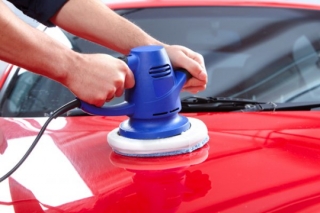
People often come to an auto body shop in Los Angeles and say they need to wax their car to make it shine or polish the car to protect its body.
In fact, there is one big misunderstanding with two different concepts – car waxing and car polishing. So what can you expect to achieve by using each of those auto body treatment methods separately?
First of all, you should know that both car waxing and car polishing are the ways how you can (and should) care about your vehicle. They not only affect the external look of the car, but also improve the body surface condition. More importantly, it is usually recommended to combine the two techniques.
Car wax
For starters, let’s examine what car waxing is. As the name says, the procedure uses wax, which is the natural substance derived from a variety of vegetable or animal compounds like bees wax or carnauba wax. The latter substance is the most popular kind of wax used in the automotive industry. This is due to a number of its natural properties, for example: the stuff is almost absolutely insoluble in water, so it will not disappear immediately after a car wash or rain shower. Its melting point is about 82-86 °C, which allows the wax to withstand high temperatures of the summer daylight without melting off the car. Additionally, carnauba wax is one of the hardest one among all natural waxes, which makes it a perfect material for putting a durable and high-glossy finish. To enhance the effect, carnauba wax is often combined with softer ingredients.
In fact, most car waxes are a combination of certain natural wax, silicone fluids, solvents, colorants and several auxiliary types of wax. Once you apply the car wax to your vehicle body, it will make the paintwork shine due to effective smoothing the surface of the paint by filling in numerous tiny imperfections of the paintwork. Even if your paintwork is evidently of a poor quality, a car waxing procedure professionally performed at an auto body paint shop can make your vehicle look much better.
Notice that there is a separate category of car waxes - “synthetic waxes”, which feature numerous synthetic ingredients added to enhance the effect. This kind of product is also called ‘sealant’. Unfortunately, you will hardly find a 100% pure carnauba wax on the market today.
Car polish
Let’s take a look at car polish products now. In contrast to car waxing, car polishing is a procedure using an abrasive action in order to remove very thin layers of the upper coat protection thus flattening out the surface and ensuring the equal reflection of the daylight and a shining look of your car.
Auto body shops can use polishes of different abrasiveness degrees – from fine to medium. Some modern products feature so called ‘diminishing abrasives’, which get finer and finer as they are polished into the paint. This kind of technology allows to avoid the need to go through numerous polishing steps using different bottles of the abrasive substance.
Many polishes contain also special oils to enhance the glossy look of the paintwork.
There is one major idea that you should understand about the polishing procedure: applying the polish does not provide any protection to the paintwork of you car. To safeguard the effect achieved by polishing, it is necessary to use car waxing. The wax (natural or synthetic) can protect the body surface for a couple to several months, depending on environment conditions, how you use and store the car, the type of wax applied and some other factors.
In fact, there is the third group of products providing a similar action. They are called ‘glazes. A glaze contains no abrasives. Instead, it contains a mix of oils able to enhance gloss. Glazes can effectively fill in any imperfections remained in the paintwork and ensure an evenly bright, shining surface. It is advisable to use glazes to avoid damaging the paintwork due to using a polish too often.
Now that you better understand the concept behind car waxing and car polishing, you can go to an auto body paint shop in Los Angeles with more confidence to discuss what you want them do with your car.